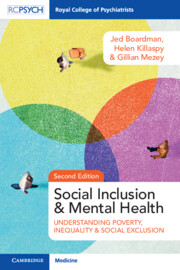Book contents
- Social Inclusion and Mental Health
- Reviews
- Social Inclusion and Mental Health
- Copyright page
- Contents
- Foreword to Second Edition
- Foreword to First Edition (2010)
- Preface
- Acknowledgements
- Chapter 1 Introduction: Poor, Excluded, and Unequal
- Section 1 Social Exclusion, Poverty, and Inequality
- Chapter 2 Social Exclusion: Basic Concepts
- Chapter 3 Social Exclusion: Applying the Paradigm to People with Mental Health Conditions – Key Aspects
- Chapter 4 Poverty and Deprivation: Getting Under the Skin
- Chapter 5 Poverty, Deprivation, and Social Exclusion in the United Kingdom
- Chapter 6 Poverty, Inequality, and Health
- Chapter 7 Social Policy, the Welfare State, and Social Exclusion
- Chapter 8 Mental Health Services and Policy in the United Kingdom
- Section 2 Participation of People with Mental Health Conditions
- Section 3 Including People
- Index
- References
Chapter 8 - Mental Health Services and Policy in the United Kingdom
from Section 1 - Social Exclusion, Poverty, and Inequality
Published online by Cambridge University Press: 24 November 2022
- Social Inclusion and Mental Health
- Reviews
- Social Inclusion and Mental Health
- Copyright page
- Contents
- Foreword to Second Edition
- Foreword to First Edition (2010)
- Preface
- Acknowledgements
- Chapter 1 Introduction: Poor, Excluded, and Unequal
- Section 1 Social Exclusion, Poverty, and Inequality
- Chapter 2 Social Exclusion: Basic Concepts
- Chapter 3 Social Exclusion: Applying the Paradigm to People with Mental Health Conditions – Key Aspects
- Chapter 4 Poverty and Deprivation: Getting Under the Skin
- Chapter 5 Poverty, Deprivation, and Social Exclusion in the United Kingdom
- Chapter 6 Poverty, Inequality, and Health
- Chapter 7 Social Policy, the Welfare State, and Social Exclusion
- Chapter 8 Mental Health Services and Policy in the United Kingdom
- Section 2 Participation of People with Mental Health Conditions
- Section 3 Including People
- Index
- References
Summary
Here we examine governmental policies that affect how people with mental health conditions are treated in society. The development of UK mental health services has been closely associated with the evolution of social policies, the increasing role of the state in the provisions for the population’s well-being, and the ‘Welfare State’. The provision of poor relief, dating from the Elizabethan Poor Law to its Victorian revision, has dominated the care of people with mental health conditions, both within and outside of institutions. Until the nineteenth century, the British state played a minimal role in the care of mental ill-health, and the 1800s witnessed a substantial growth in publicly funded asylums. These County Asylums were Poor Law institutions and remained so into the twentieth century. The UK’s modern mental health services arose from the Beveridge welfare state reforms but carried with them much of the baggage of the Victorian Poor Laws. The close relationship between the welfare state and mental health services illustrates the importance of social policy provision relating to income, employment, housing, education, health, and personal social services, to the broader provision of services for people with mental health conditions and the running of effective mental health services.
- Type
- Chapter
- Information
- Social Inclusion and Mental HealthUnderstanding Poverty, Inequality and Social Exclusion, pp. 161 - 186Publisher: Cambridge University PressPrint publication year: 2022



